How to make a florarium with succulents with your own hands?
The modern rhythm of life of many people does not leave enough time for the cultivation of indoor plants. What if you want to delight the eye with greens, but careful daily care of it is impossible? Try to make your own florarium with succulents, which requires little or no maintenance.
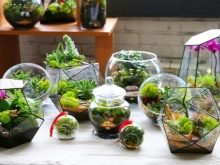
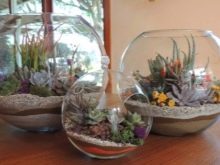

What it is?
A florarium is a container with moisture-loving plants made of glass or transparent plastic. It has a narrowed throat or roof to create a special microclimate. Another interesting name for such a composition is the bottle garden.
A terrarium for plants is a real boon for small apartments, as it allows you to place several plants in it at once. A beautiful flowerpot with an unusual shape will make it a worthy interior decoration.
The soil is usually laid out in layers, which also looks pretty nice. In the florarium, the root system of plants is visible, and this is very interesting.
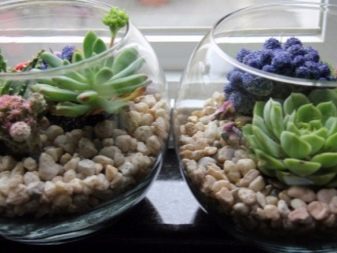
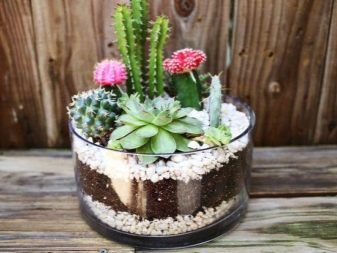
The convenience of this kindergarten also lies in the fact that pets and children cannot get to its insides. After all, ordinary plants are often gnawed by cats, and a curious baby can cut off the leaves of an indoor succulent or run into the thorns of a cactus.
The florarium eventually forms its own mini-ecosystem. This is useful for tropical plants that like excess moisture and no drafts.
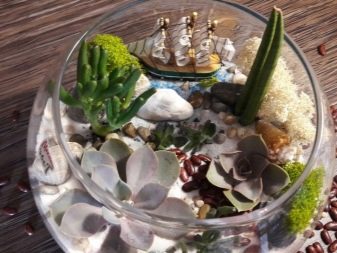

Plant selection
Succulents that are suitable for the florarium are very diverse both in appearance and in their structure. Their choice depends on the taste and preference of the manufacturer. The recommended list includes such plants.
- Cacti. These desert dwellers in a closed transparent container, together with other plants, look just wonderful. Their greenery and thorns begin to play with new colors, and the appearance of the florarium becomes elegant and stylistic. Cacti grow slowly, live well in conditions of rare watering, which makes them simply irreplaceable inhabitants of a vegetable terrarium.
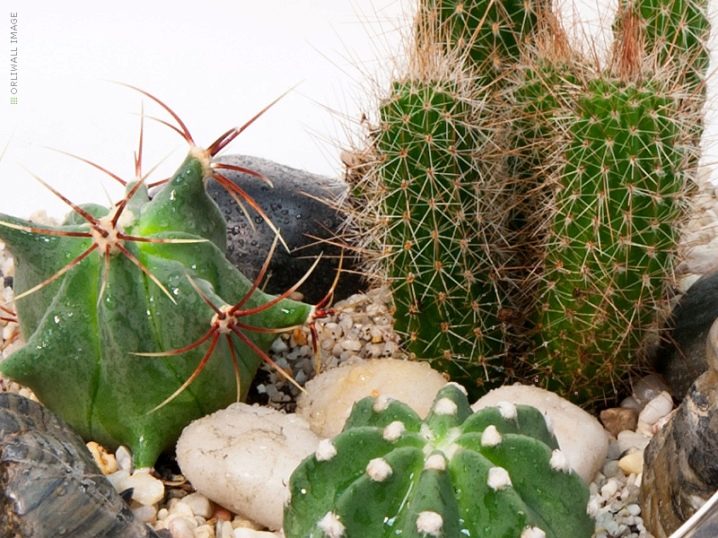
- Rejuvenated, or "stone rose". This plant has interesting leaves that gather in rosettes that resemble rose petals. Rejuvenated, undemanding to care, pleases with a variety of shapes and colors of leaves. Therefore, its proximity to cacti and other plants in the florarium will look very organic.
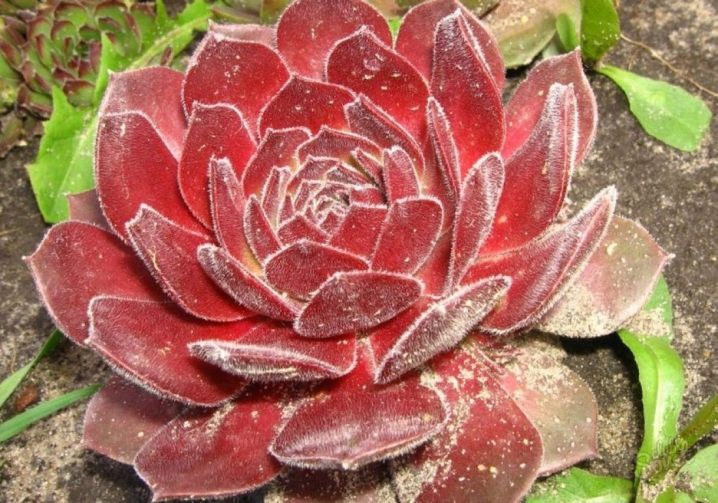
- Agave. Sharp leaves, collected in rosettes, in this succulent are visually associated with the Mexican prairies. The color of lanceolate shoots can be different: from monochromatic grayish-green to emerald. Sometimes the leaf is emphasized by a yellowish border.
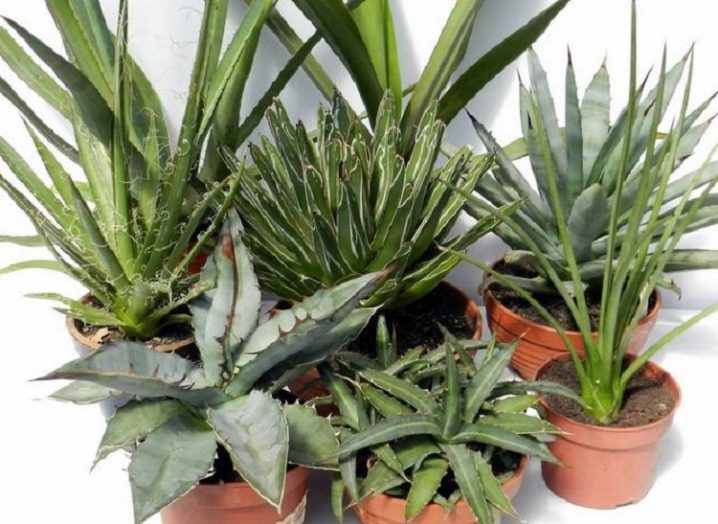
- Echeveria. This plant has fleshy shoots of dark green color. In simple pots, it looks rather inconspicuous, but it can easily reveal its beauty in the florarium. Gray leaf pubescence looks tender, like a bloom of frost on the shoots. Will go well with ferns and lichens.
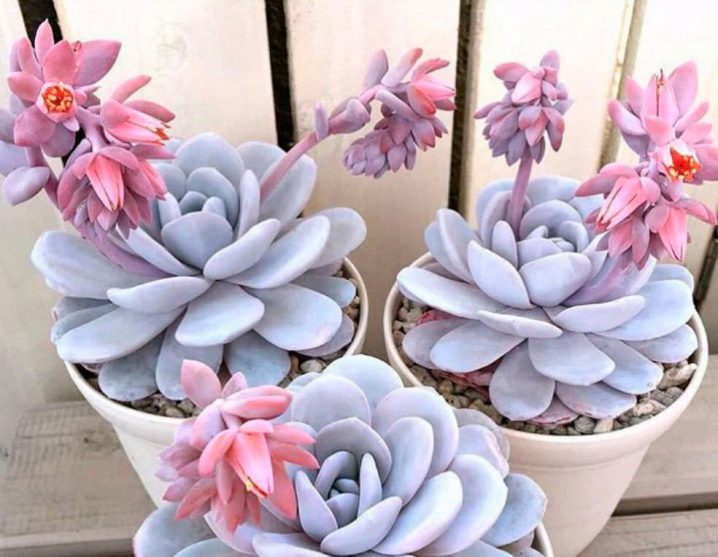
- Aloe. This succulent can be more compact than the huge bushes in pots on the windowsills of our grandmothers familiar to everyone. The fleshy, thorny leaves of this plant look great under glass. There are species whose shoots resemble geometric shapes, there are also simpler specimens. All varieties of aloe are equally unpretentious, which is a huge plus for use in the florarium.

- Haworthia. Outwardly, many confuse this succulent with agave. Indeed, the shape of the bush is rosette, and the leaves are elongated and lanceolate. If we talk about the most common classic haworthia, then it is distinguished by a denser and more compact structure of the shoots, as well as warty light stripes on the leaves. Haworthia looks great in florariums and has a big plus - it grows slowly and does not require serious care.

- Adromiscus. This plant has perhaps the most interesting succulent leaves. Different varieties can attract attention with shoots in the form of a club, triangles, mollusks - who has any imagination. Therefore, everyone can choose this plant to their taste. The leaves are collected in small dense rosettes.

- Kalanchoe. It is not a rosette succulent. Usually, all Kalanchoe form bushes, which will make the composition with them in the florarium complete in appearance. Instances with decorative leaves are interesting in color. The numerous babies that Kalanchoe releases also look very cute.
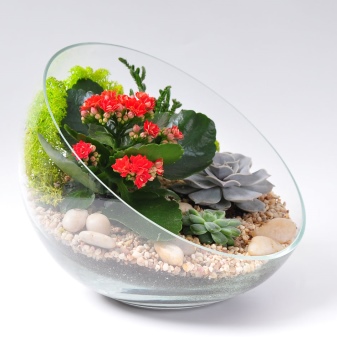
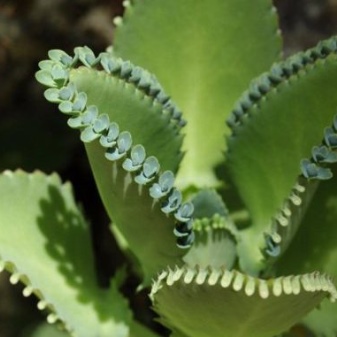
- Ragwort. The most popular type of this plant is Senezio Rowley. It resembles a string with beads that lie beautifully on the ground. A very interesting succulent, undemanding to care for.
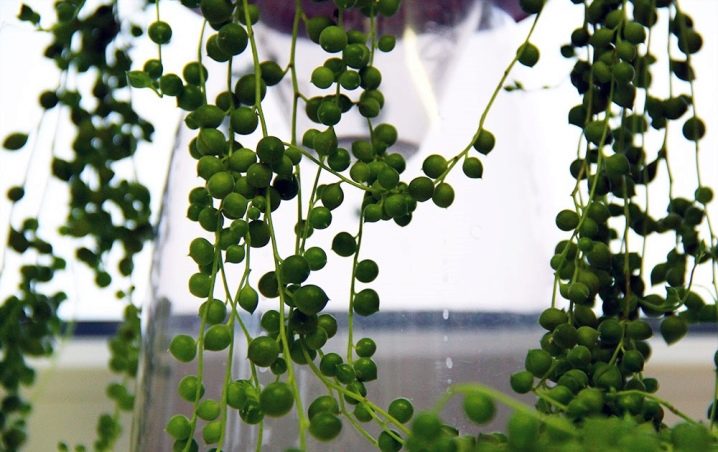
- Malefora. This succulent is often used in dry flower beds, as it strikes with its vigorous flowering. But it will also look original in florariums. Its leaves are small, strewn with a long, creeping shoot. The bluish bloom will effectively shade the ferns and lichen.
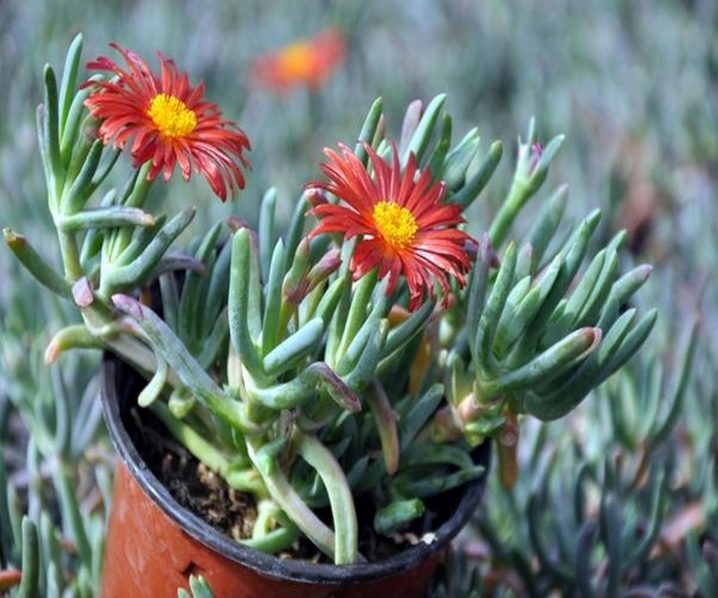
- Fat women. For example, the notorious money tree or euphorbia looks great when paired with cacti and other succulent plants. The fleshy leaves of the bastard with a rich green tint will decorate any garden in a bottle.
The florarium is interesting when there is a play of contrasts in it.
Spiky and smooth, blotchy and bright green - all this variety can be embodied in the plant terrarium. Plants of more than one type can be included in the composition. Allocasia, fetonia, mosses and mini ferns will work well with succulents.
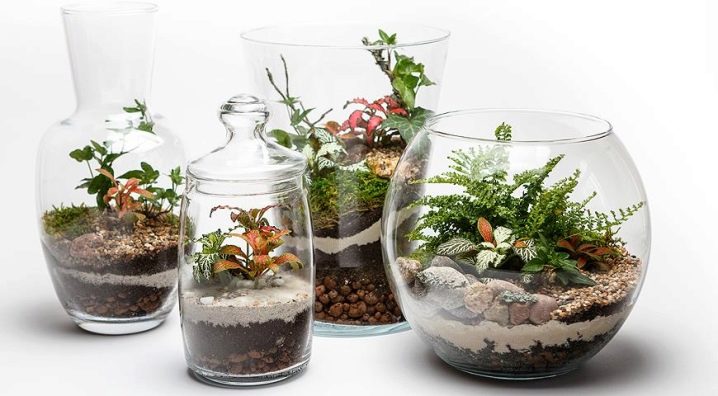
Suitable capacity
There are many items on sale that can be adapted for the future garden for succulents. In addition to the banal glass containers purchased in flower shops, you can even find a transparent case for plants at home.
- The aquarium is round and square. If you previously had fish, and their house was left idle, then it may well accommodate new inhabitants. Buying aquariums is also not difficult, the main thing is to choose the optimal size. Glass balls, originally intended for fish, look beautiful.
- Vases. An inexpensive option, which is also easy to find, is an ordinary flower vase. It can be purchased at any supermarket or hardware store. A minimalist transparent flower container can become a succulent terrarium in a matter of hours.
- Vessels and flasks for experiments. In such containers, florariums will look ultramodern. Of course, the flasks must be of a suitable size, especially their neck.
- Big light bulbs. Mini-plants will decorate something as vintage as an old spoiled light bulb. Such a terrarium looks like succulents sprouted in it by accident, when the light bulb was thrown out in the forest.
- Kitchenware. Decanters, glasses, flowerpots, teapots, jars - all this can serve as a receptacle for succulents, if made of ordinary glass without relief.
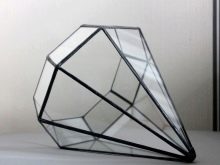
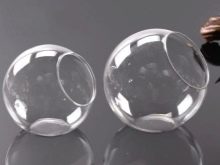
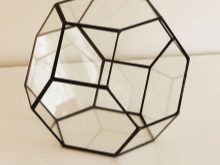
What kind of soil is needed?
The easiest solution is to buy ready-made succulent soil from a flower shop. It does not need to be fertilized, it does not contain unnecessary bacteria and is convenient to use.
If you want to use homemade soil, a mixture of peat and sand in equal proportions is the best solution. You can also mix the soil with sand and bake it in the oven to kill mold and mildew.Since the florarium is a closed container, the chances of the formation of such problems in it increase markedly.
It is imperative to use drainage at the bottom of the garden. It can serve as coarse sea sand, small pebbles or expanded clay.
Adding charcoal to the drain is a great solution.
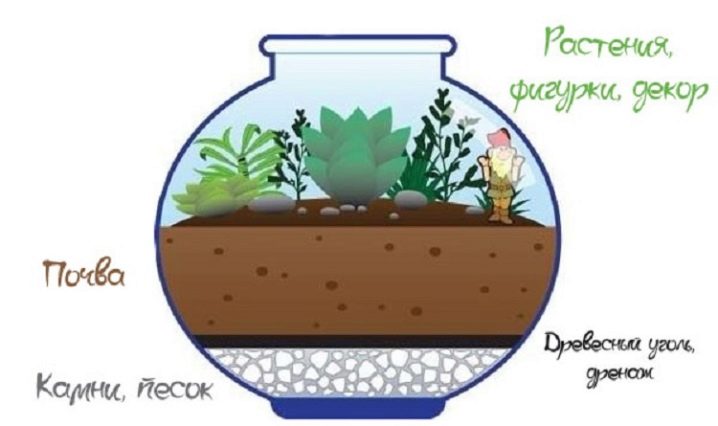
Popular compositions
Glass gardening is true creativity at its best. Currently, both a mixture of styles and individual categories of florariums are popular. Let's consider the main ones.
- Desert theme. A composition of small cacti will decorate a small windowsill or office interior. The style basis here is sand, which can be combined with stones and pebbles. They will look beautiful and rejuvenated.
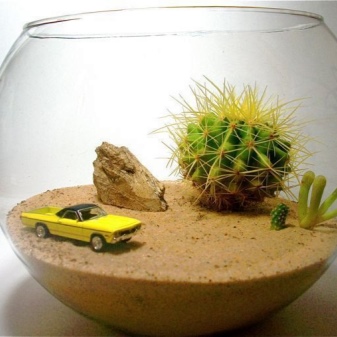

- Forest florarium. In such a composition, it is important to design the tiers. In the far background, you need to place taller plants, and in the front - low ones (cacti, ivy, mosses). The set of succulents is perfectly emphasized by decorative ferns. In this style, it's a good idea to add artificial small flowers or mushrooms.
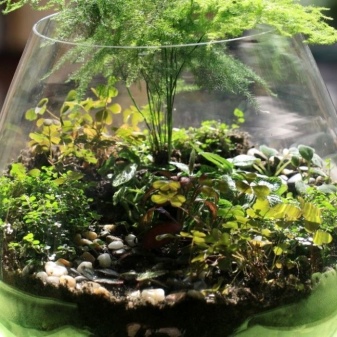
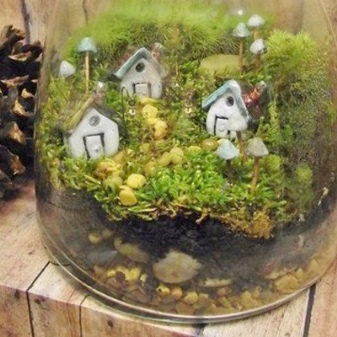
- Stone geometry. Sharper forms of florariums can be emphasized by strict geometric forms. For this, certain plants are chosen, for example, agave with clear lanceolate leaves. Large stones can be placed in such a terrarium.

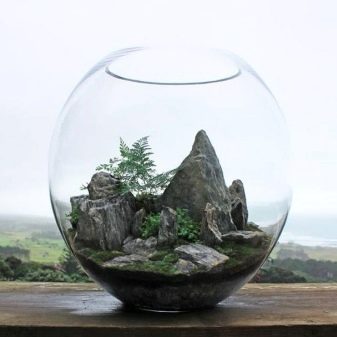
Ceramic garden figurines of the smallest sizes are often added to florariums. They look appropriate with the dark greenery of the garden in a bottle and slightly dilute the cold composition.
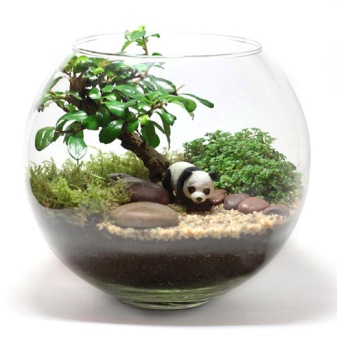
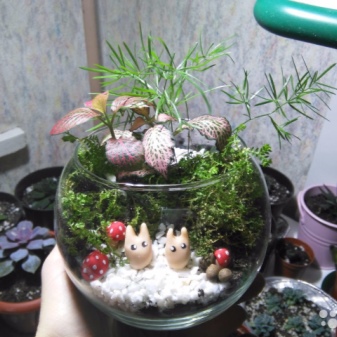
How to do it yourself?
When creating a florarium with your own hands, it is important to strictly follow a certain algorithm. It is not enough to plant plants correctly, because such a masterpiece includes many subtleties. We offer you a master class in the form of step-by-step instructions on creating a garden in glass.
- Decide on an idea. Each creation should be liked by its creator. Therefore, choose exactly the style of florarium that you like.
- Choose a location. Much depends on where the terrarium with plants will stand. The future vessel must be selected taking into account the parameters of this place.
- Purchase and prepare a vessel. Choose a ready-made florarium in the store or find a suitable container at home. Before planting plants, you must thoroughly wash their future home and wipe the inside with alcohol. This will kill all pathogenic bacteria, as well as get rid of fingerprints, which will be highly visible.
- Pick up plants and test them for compatibility. A rapidly growing Kalanchoe will conflict with cacti, which develop almost imperceptibly. It is better to choose those succulents and plants that have a similar growth rate and susceptibility to environmental conditions.
- Get the necessary soil, drainage, and decorations. The soil is the most important for the well-being of future residents of the florarium. Therefore, at the moment, close attention should be paid. Decorations will complement any garden and make it unique.
- Prepare the table and place everything you need on it. For the successful creation of a florarium, you must be convenient and comfortable. And for this you need to place all the elements so that you can reach them with your hand. Remove the plants from the pots and rinse their root systems under warm water.
- Put on gloves. Fingerprints inside the florarium after planting will be almost impossible to wipe off, and they will spoil the appearance quite strongly.
- Add soil and other ingredients. At the bottom, lay a layer of sand about 1 cm, then expanded clay with charcoal of the same thickness. Choose a soil layer depending on the longest root system. The plant should sit comfortably in the soil so that all roots are completely covered with soil.
- Make holes for the plants and plant them. They should not overlap each other with leaves. Consider this, as they will still grow.After making the holes at the optimal distance, start planting succulents, being careful not to damage the roots. The leaves and shoots of plants should also not touch the walls of their new home.
- It's time for the decor. After planting all the plants, arrange all the planned elements: decorative sand, stones, ceramic figures.
- Water the plants and close the lid. Lightly moisten the soil near each plant. Cover the florarium with a lid, if provided by the design.
Subtleties of care
Florarium is the best option for busy people. Caring for him is minimal, but still it is simply necessary to carry out it periodically. It is as follows.
- Finding the right place. Direct sunlight is the enemy of such a creation, but a full shadow will ruin the life of succulents. It is necessary to keep the florarium in the northern part of the apartment or office in the summer, and in the winter you can place it under the occasional falling sunlight. If the plants have begun to turn yellow, then they need an additional source of lighting. Keep the garden in glass away from heating appliances. The optimum temperature for such interior decorations is from 22 to 28 ° C.
- Watering. It is extremely rare to moisten the soil in the florarium, no more than 1 time per week. It is better to control watering yourself. If the soil inside looks dry, and the moss begins to wrinkle a little, it's time to water the flowers. Excess moisture is extremely dangerous for such a garden, so it is important to monitor the amount of liquid inside. If you have poured water into the florarium, tilt it slightly and remove the excess with a rag or paper napkins.
- Airing. To avoid putrefactive processes, it is very important to carry out ventilation in the florarium. This is especially true for kindergartens with a closed lid. Do this several times a week, and then your creation will delight you as long as possible.
As you can see from this list, caring for a florarium is not at all difficult. And the aesthetic pleasure from it many times exceeds the labor costs for its creation and even more so for its care.























































The comment was sent successfully.